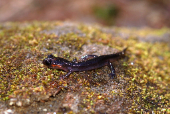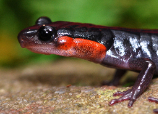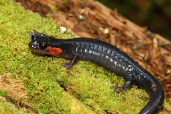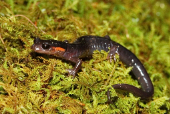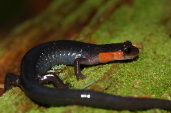Red-Cheeked Salamander (Plethodon jordani
)
Description: The red-cheeked salamander is a uniform steely grey colour with conspicuous red, orange or yellow patches on the side of the head. The imitator salamander (Desmognathus imitator) is thought to be a mimic and is very similar in appearance but has a pale line joining jaw to eye and more robust hind legs.
Habitat: The red-cheeked salamander is a terrestrial species and is found in both hardwood and coniferous forests, particularly in the Southern Appalachian spruce–fir forest. It is plentiful in areas with a ground cover of moss and leaf litter among large boulders.
Range: The red-cheeked salamander is found in mountainous areas of the southeastern United States. The main populations are along the border between North Carolina and Tennessee. The altitude range is 700 to 6400 feet, but a few specimens are found below 2,000 feet. Almost the whole altitude range occurs within the boundaries of the Great Smoky Mountains National Park.
Found in these States:
NC |
TN
Diet: The red-cheeked salamander feeds on small invertebrates including worms, snails, springtails, spiders, insects and insect larvae.
Reproduction: Little is known of the breeding habits of the red-cheeked salamander, but they are likely to be similar to those of other members of the genus Plethodon with a clutch of eggs being brooded by the female and each egg developing directly into a juvenile without an intervening larval stage.
Status: Listed as Near Threatened because the continued survival of this species is entirely dependent on the protection and rigorous management of its habitat provided by the Great Smoky Mountains National Park. Without this level of protection, it is very likely that the species’ habitat would be degraded and fragmented resulting in significant population declines, which would warrant an immediate uplisting.
»» Kingdom: Animalia - Animals
»» Phylum: Chordata - Chordates
»» Subphylum: Vertebrata - Vertebrates
»» Class: Amphibia - (Amphibians)
»» Order: Caudata - Salamanders
»» Family: Plethodontidae - Lungless Salamanders
»» Genus: Plethodon
»» Species: Plethodon jordani - Red-Cheeked Salamander
This article uses material from the Wikipedia article "Red-Cheeked Salamander", which is released under the Creative Commons Attribution-Share-Alike License 3.0. Content may have been omitted from the original, but no content has been changed or extended.
|



